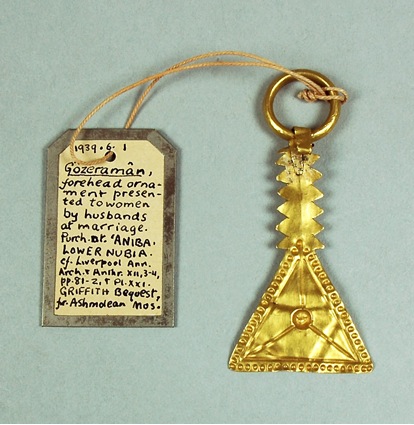Gold forehead ornament
Nubia, Sudan
 Collected by Francis Llewellyn Griffith and donated by him via the Ashmolean Museum in 1939; 1939.6.1The Nubians have traditionally lived on the banks of the Nile southern Egypt and northern Sudan. Now a predominantly Muslim culture, their marriage traditions embody a fusion of traditional and Islamic customs. This ornament, cut from gold sheet and embossed was presented to a woman by her husband at marriage and worn on her forehead. Its triangular shape derives from the triangular or scorpion-shaped amulets and charms worn for good luck and to protect from the Evil Eye. They are sometimes inscribed with a verse from the Koran.
Collected by Francis Llewellyn Griffith and donated by him via the Ashmolean Museum in 1939; 1939.6.1The Nubians have traditionally lived on the banks of the Nile southern Egypt and northern Sudan. Now a predominantly Muslim culture, their marriage traditions embody a fusion of traditional and Islamic customs. This ornament, cut from gold sheet and embossed was presented to a woman by her husband at marriage and worn on her forehead. Its triangular shape derives from the triangular or scorpion-shaped amulets and charms worn for good luck and to protect from the Evil Eye. They are sometimes inscribed with a verse from the Koran.
Among the Nubians, marriage between cousins is quite common and sometimes obligatory. This keeps the cost of the dowry down and strengthens kinship ties within the tribe. Upon her engagement, the girl would receive gifts of jewellery from her fiancé and his family as well as heirloom gold jewellery from her female relatives. The association of gold with marriage means that widows refrain from wearing their gold jewellery.
A Nubian wedding ceremony, known as nikah, can last up to forty days with a long series of rituals. The girl wears her forehead ornament as well as henna designs on her skin and colourful silk garments, whilst the groom is also well dressed, holding a sword and a whip. Since the Nile plays such an important rule in Nubian culture, the couple go down to the river an on their wedding night and wash into water to ensure prosperity, good health and numerous children. The first obligation a bride is expected to perform after the ceremony when she reaches her new home is to prepare a meal for her new family. If the family is not impressed, there is a real possibility that the bride will be sent back to her parents so that she can perfect her cooking skills.
